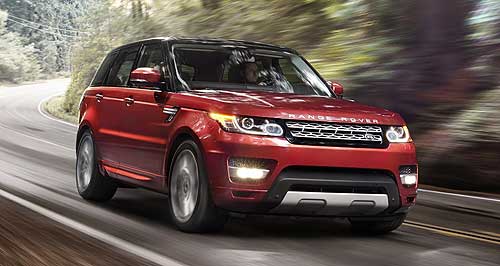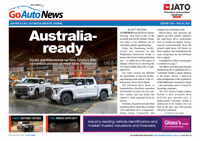Make / Model Search
Future models - Land Rover - Range Rover SportNew York Show: Range Rover gets sportyExpecting: The middle child in the Range Rover family – the Sport – enters its second generation this week, with Australian deliveries to commence in November. Second-gen Range Rover Sport adds seven-seat option, launches here in NovemberGallery Click to see larger images 27 Mar 2013 THE lighter, faster and more family friendly second-generation Range Rover Sport has been outed in New York ahead of an arrival in Australian showrooms in November. The Big Apple was deemed perfect for hosting the premiere because, as Range Rover puts it, the US is the biggest-selling country for the Sport, and New York the best-selling city therein. Featuring a ground-up redesign, the new iteration of Range Rover’s middle child is said to have been more clearly positioned between the smaller Evoque and the larger, full-size Range Rover. The company says the Sport is 149mm shorter and 55mm lower than the traditional Range Rover, and is model-for-model around 45kg lighter. Developed alongside the aforementioned larger flagship, the Sport shares the same full aluminium body structure, resulting in weight savings of up to 420kg over the superseded, separate-chassis version. The platform alone is 39 per cent lighter than before. With these improvements comes a subsequent step up in driver dynamics, with Range Rover calling the new Sport its “fastest, most agile, most responsive model ever”. It’s all in the name, we guess. But while the company labels the Sport as among its most “road-focused” designs to date, purists can rest easy in the knowledge that it also comes with its big brother’s Terrain Response system, adjustable air suspension, full-time four-wheel-drive, low-range gearing and 546mm of wheel articulation for the rough stuff. The Sport is also the best choice for the school run, being the first Range Rover model available with the option of seven seats. At 4850mm long, the Sport is shorter than most seven-seaters, but its 178mm longer wheelbase allows the temporary third row to be accommodated. Four engines have been confirmed from local launch – a 3.0-litre turbo-diesel V6 in 190kW/600Nm or 215kW/600Nm states of tune, a 250kW supercharged V6 petrol and a range-topping 375kW 5.0-litre supercharged V8 petrol. Range Rover claims the V6 diesels are up to 15 per cent more efficient than the equivalent outgoing unit, with carbon dioxide emissions down to 194 grams per kilometre. The supercharged V6 petrol version, meanwhile, can dash from zero to 100km/h in a claimed 7.2 seconds – three-tenths faster than the V8 that preceded it. The supercharged V8 brings this down to a sportscar-like 5.3s. A big daddy 250kW/700Nm 4.4-litre V8 diesel will join the range a few months after the six-cylinder versions. Range Rover has also confirmed it will introduce a diesel-hybrid version in 2014 that consumes a remarkable 6.3L/100km around the same time as a similar version premieres in the larger Range Rover. A four-cylinder is also confirmed to be on the cards, thanks to the big weight reductions. The company’s Australian arm has confirmed all the powertrains – including the hybrid - will be launched here in time, with the exception of the four-cylinder which is still under global evaluation. S, SE, HSE and Autobiography specification levels will be available, as well as sportier Dynamic version of the latter pair. All engines in the range are matched to an eight-speed automatic transmission sourced from ZF and shared with the regular Range Rover. The nine-speeder that debuted this month in the Evoque will not be fitted, since it only suits transverse layouts, not the Sport’s longitudinal configuration. The cabin is similar in design to its big brother, with a clean and simple design, but with a smaller steering wheel, different gear shifter, higher centre console and bigger seat bolsters to lend a sportier feel. High-tech driver aids such as torque vectoring (which adjusts torque delivery to the wheels to alleviate understeer), a heads-up display that shows trip and navigation data and a digital camera bank with Lane Departure Warning, Traffic Sign Recognition and high-beam assist will be offered. Range Rover sold 380,000 units of the first-generation Sport, launched globally in 2005. The new model will be available in 169 countries.  All motor show Alfa Romeo Alfa Romeo Abarth Abarth Alpine Alpine Alpina Alpina Audi Audi Aston Martin Aston Martin BMW BMW Bentley Bentley Chery Chery Brabham Brabham Chrysler Chrysler Chevrolet Chevrolet Cupra Cupra Citroen Citroen DS DS Dodge Dodge Fiat Fiat Ferrari Ferrari Foton Foton Ford Ford Great Wall Great Wall FPV FPV Haval Haval GWM GWM Honda Honda Holden Holden Hummer Hummer HSV HSV Infiniti Infiniti Hyundai Hyundai Jaguar Jaguar Isuzu Isuzu Kia Kia Jeep Jeep Land Rover Land Rover Lamborghini Lamborghini Lexus Lexus LDV LDV Mahindra Mahindra Lotus Lotus Mazda Mazda Maserati Maserati Mercedes-AMG Mercedes-AMG McLaren McLaren MG MG Mercedes-Benz Mercedes-Benz Mitsubishi Mitsubishi Mini Mini Opel Opel Nissan Nissan Peugeot Peugeot Pagani Pagani Proton Proton Porsche Porsche Renault Renault Ram Ram Rover Rover Rolls-Royce Rolls-Royce Skoda Skoda Saab Saab SsangYong SsangYong Smart Smart Suzuki Suzuki Subaru Subaru Toyota Toyota Tesla Tesla Volvo VolvoMotor industry news |
Click to shareAll motor show Alfa Romeo Alfa Romeo Abarth Abarth Alpine Alpine Alpina Alpina Audi Audi Aston Martin Aston Martin BMW BMW Bentley Bentley Chery Chery Brabham Brabham Chrysler Chrysler Chevrolet Chevrolet Cupra Cupra Citroen Citroen DS DS Dodge Dodge Fiat Fiat Ferrari Ferrari Foton Foton Ford Ford Great Wall Great Wall FPV FPV Haval Haval GWM GWM Honda Honda Holden Holden Hummer Hummer HSV HSV Infiniti Infiniti Hyundai Hyundai Jaguar Jaguar Isuzu Isuzu Kia Kia Jeep Jeep Land Rover Land Rover Lamborghini Lamborghini Lexus Lexus LDV LDV Mahindra Mahindra Lotus Lotus Mazda Mazda Maserati Maserati Mercedes-AMG Mercedes-AMG McLaren McLaren MG MG Mercedes-Benz Mercedes-Benz Mitsubishi Mitsubishi Mini Mini Opel Opel Nissan Nissan Peugeot Peugeot Pagani Pagani Proton Proton Porsche Porsche Renault Renault Ram Ram Rover Rover Rolls-Royce Rolls-Royce Skoda Skoda Saab Saab SsangYong SsangYong Smart Smart Suzuki Suzuki Subaru Subaru Toyota Toyota Tesla Tesla Volvo VolvoMotor industry news |










































Facebook Twitter Instagram